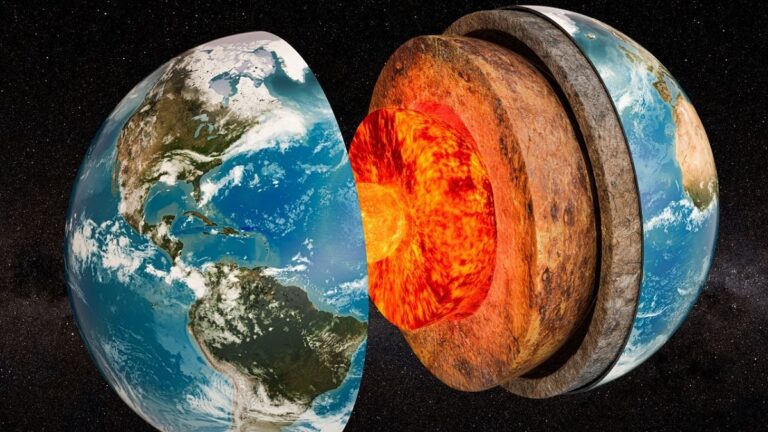In a groundbreaking scientific breakthrough, researchers have unveiled the existence of a colossal underground ocean, potentially containing three times more water than all the surface oceans combined. This discovery, which comes from studying the mineral ringwoodite, could completely change our understanding of Earth’s water cycle and its geological history.
A Revolution in the Understanding of Earth’s Hydrosphere
The discovery centers around the analysis of ringwoodite, a rare mineral found in a transition zone of the Earth’s mantle, located between 400 and 600 kilometers beneath the surface. Using advanced seismic technology, scientists were able to detect seismic waves traveling through this region, leading them to conclude that a massive quantity of water is trapped within the crystal structure of this mineral.
What makes this discovery so astonishing is that ringwoodite, which forms under extreme pressure and temperature conditions, has the ability to absorb water into its structure, storing it deep within the Earth. This vast underground water reservoir has likely been accumulating for billions of years, and its implications for the hydrosphere are profound. This new finding raises a fascinating question: could part of Earth’s water have originated from deep within the planet itself, rather than from external sources such as icy comets, as many theories previously suggested?
Environmental and Climatic Implications
The presence of such a massive water reservoir deep within the Earth could have far-reaching consequences for our understanding of the planet’s climate and water cycles. The deep ocean could potentially act as a “recharge system” for the surface oceans, influencing sea levels over long geological periods. Additionally, researchers are beginning to explore whether this subterranean water plays a role in tectonic processes such as subduction and volcanic activity, which could have indirect effects on the surface ecosystems.
The discovery of this hidden water might also influence our understanding of the planet’s climate stability over millions of years. If the Earth’s internal water acts as a natural buffer, it could help regulate fluctuations in the ocean’s water levels, contributing to long-term climate patterns and helping to stabilize global temperatures.
Tectonic and Volcanic Effects
Another intriguing possibility is that the enormous amount of water trapped deep within the Earth could be contributing to tectonic activity. A concentration of water at such depths could lead to more intense tectonic movements, including earthquakes and volcanic eruptions. The presence of water in the mantle could potentially alter the dynamics of plate movements, and the release of gases during volcanic eruptions might even have an impact on the carbon cycle and greenhouse gas levels.
As scientists continue to investigate these possibilities, they are considering the broader impact of this underground water reservoir on the stability of the planet’s surface and the long-term effects on geological processes.
Future Perspectives and Scientific Challenges
As researchers dive deeper into this discovery, many challenges remain. The vast depths at which this hidden ocean resides make direct exploration incredibly difficult. However, with advancements in seismic technology and laboratory simulations, scientists hope to soon gain further insight into the composition and behavior of this massive water reserve.
In the coming years, scientists aim to analyze the chemical composition of this subterranean water to understand its role in Earth’s geological and biological cycles. Could this hidden water have provided favorable conditions for the emergence of life? Did it play a crucial part in the formation of organic molecules that eventually led to the first living organisms? These are questions that future research may begin to address.
The discovery of this underground ocean marks a monumental step forward in the fields of geology and Earth sciences, opening new doors to understanding the planet’s history, the water cycle, and even the origins of life itself.
Summary of Key Points:
- A massive underground water reservoir has been discovered beneath Earth’s crust, potentially containing three times more water than all the surface oceans combined.
- This water is stored in ringwoodite, a mineral capable of absorbing water at depths between 400 and 600 kilometers below the surface.
- The discovery challenges traditional theories about the origin of Earth’s water, suggesting that some of it may have come from deep within the planet.
- The implications for environmental and climate sciences are significant, with potential impacts on ocean levels, the carbon cycle, and tectonic movements.
- Future research will focus on understanding this subterranean water, including its role in Earth’s geological evolution and its potential connection to the emergence of life.






![Recensione Concerto: KRUDER & DORFMEISTER trent’anni di visioni [Info e Scaletta]](https://www.wecb.fm/wp-content/uploads/2025/04/Concert-review-Kruder-Dorfmeister-thirty-years-of-visions-info.webp-150x150.webp)